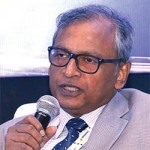
A city comes with a certain level of complexity and must be handled well. And this complexity cannot be handled if we look at it in parts. We must necessarily take a holistic view.
– Prashun Dutta
Prashun Dutta: We tend to look at the whole thing in silos through our narrow perspectives, one department and jurisdiction. So, I think that now we need to understand that
We cannot look at just the transportation system of a city. We have done that for long and we have seen the results are not good. For instance, Mumbai is suffering from an excessive density of people. That is because we have spoiled the land use pattern completely. A very low land use pattern is not advisable, I know in many of the European countries and the US, there is this problem of very low land use patterns where the populations are very scattered and so delivering services becomes very expensive. But at the same time the density that we have is abnormal. In any place you go, buildings and multi-storied buildings with roads have remained same for the last 40-50 years, so this is just not workable. We should look at everything together, the resources, the roads, the buildings, the administration and the land use pattern.
Rupesh Mehta: As a country, India has a very good awareness and we have very good support and a good vision of smart cities. But we are still struggling on a few pointers which can be summarized as below — Reactive versus proactive approach, PPP model versus government funded model, revenue model versus safety, existing technology versus new technology, make in India versus imported technology.

We had a good start of smart city concept with strong support and vision from the government, however there is a need for more attention and focus to conceptualize the overall vision in to executable projects.
– Rupesh Mehta
When we talk about the model of a smart city altogether, we need to have a strategy that talks about how these models can be self-sustainable so that all these pointers are covered and addressed.
Now, there are different ways to deal with that. For e.g, if we talk about the PPP model or the government funded model, we need to have long term strategy to ensure interest of all stake holders are served. There is no point of having a model that puts entire burden on bidder without any revenue assurance, as this will lead to poor standards. Overall echo system needs to be created that will show benefits to bidders as well as end users then only concept of smart city will go long way and we will see good investments in technology that will benefit people and in turn will ensure good returns.
Smart city tender RFP needs to be designed to accommodate all above aspects and should be technology agnostic. We see many times that technology or solutions are pushed instead of designing it as per the requirement of states. Adaption of new technology to meet the Indian condition is the most important point. If I have a solution I cannot push that solution unless and until it is actually meant for the problem. It needs to be created and customized to suit the conditions of our country.
To summarize, I feel that we had a good start of smart city concept with strong support and vision from the government, however there is a need for more attention and focus to conceptualize the overall vision in to executable projects which should be done considering needs and requirement of people and country. It is required that the government, consultants, and bidders should involve teams with thoughtful people who can translate requirements of states and people into well planned strategy and project that attract good investment in technology with assured returns and create self sustainable model.
 TrafficInfraTech Magazine Linking People Places & Progress
TrafficInfraTech Magazine Linking People Places & Progress

